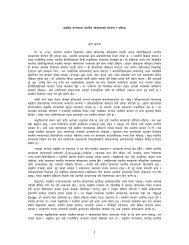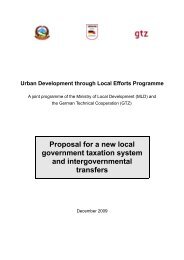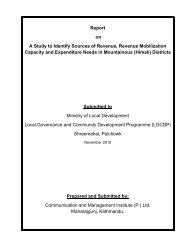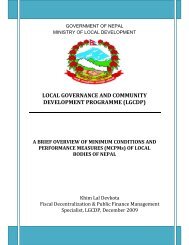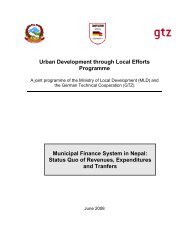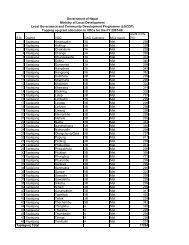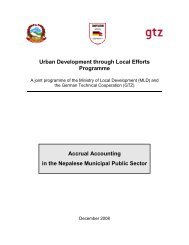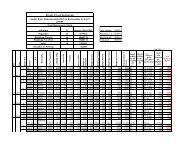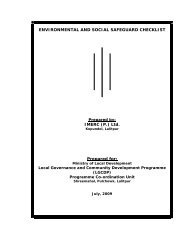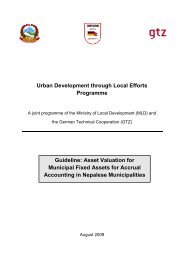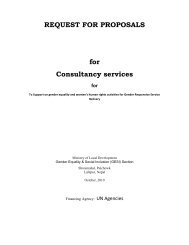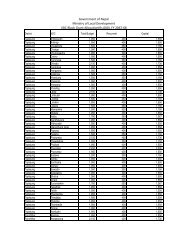LGCDP M&E Framework
LGCDP M&E Framework
LGCDP M&E Framework
You also want an ePaper? Increase the reach of your titles
YUMPU automatically turns print PDFs into web optimized ePapers that Google loves.
LOCAL BODIES FISCAL COMMISSION / DMIS<br />
Indicator: LBFC database contains data on internal and external revenue generation<br />
disaggregated by all DDCs, all VDCs and all municipalities<br />
Rationale: Strengthened policies and institutional frameworks require reliable data for decisionmaking.<br />
A key function of the Local Bodies Fiscal Commission is the collection and analysis<br />
of data from DDCs, VDCs and municipalities.<br />
Limits: • The indicator is not registering partial progress, but is only registering<br />
progress if data by all three levels of local governance are available.<br />
Baseline: No (2009)<br />
Target: Yes (2012)<br />
Means of<br />
LBFC database<br />
Verification<br />
Frequency annually<br />
Responsibility <strong>LGCDP</strong> PCU<br />
Indicator: Number of unique visitors on DMIS section in MLD website per trimester<br />
Rationale: This proxy indicator tracks both the availability and quality of data collected by the Local<br />
Bodies Fiscal Commission. The underlying assumption is that the number of users<br />
accessing data from DMIS will only increase and remain at a high level if a) sufficient data<br />
is publicly and easily available and b) this data is of sufficient quality. This data can be<br />
easily collected using free online tools like Google Analysis.<br />
Limits: • The indicator only captures web-based access to data from the data base.<br />
The underlying assumption is that changes in web-based access correspond<br />
with the overall use of the data.<br />
• By tracking “unique visitors”, the same visitors accessing data on different<br />
days are counted multiple times.<br />
Baseline: 0 (2009)<br />
Target:<br />
To be determined<br />
Mov<br />
MLD website<br />
Frequency annually<br />
Responsibility M&E Section of MLD<br />
LOCAL BODIES ASSOCIATIONS<br />
Indicator: % of LDOs in DDCs who think that ADDCN is performing better now then one<br />
year ago<br />
Rationale: This indicator tracks the perception of changes in ADDCN performance and the satisfaction<br />
of its main clients over time. It serves as a proxy for changes in the performance of this<br />
Local Body.<br />
Limits: • The indicator tracks perceptions rather than actual changes. The underlying<br />
assumption is that significant improvements in performance will – over time –<br />
be reflected by changes in the perception of its key clients.<br />
Baseline: To be determined by <strong>LGCDP</strong> baseline survey in 2009<br />
Target:<br />
To be determined after the <strong>LGCDP</strong> baseline survey<br />
Means of<br />
Sample surveys by MLD<br />
Verification<br />
Frequency Every 2 years (2009, 2011, 2013)<br />
Responsibility M&E Section of MLD<br />
Indicator: % of Executive Officers in municipalities who think that MuAN is performing<br />
better now then one year ago<br />
Rationale: This indicator tracks the perception of changes in MuAN performance and the satisfaction<br />
of its main clients over time. It serves as a proxy for changes in the performance of this<br />
Local Body.<br />
Limits: • see above<br />
Baseline: To be determined by <strong>LGCDP</strong> baseline survey in 2009<br />
Target:<br />
To be determined after the <strong>LGCDP</strong> baseline survey<br />
Mov<br />
Sample surveys by MLD<br />
Frequency Every 2 years (2009, 2011, 2013)<br />
Responsibility M&E Section of MLD<br />
20



